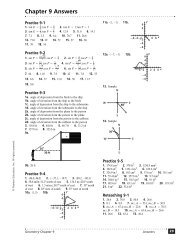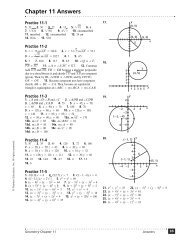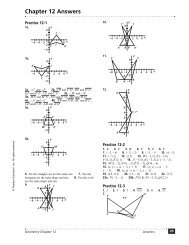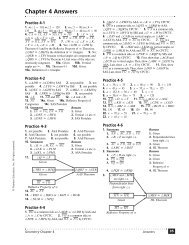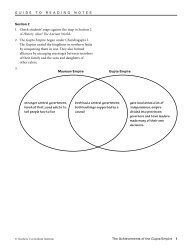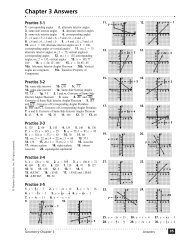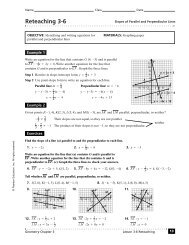Chapter 12 Sequences; Induction; the Binomial Theorem
Chapter 12 Sequences; Induction; the Binomial Theorem
Chapter 12 Sequences; Induction; the Binomial Theorem
You also want an ePaper? Increase the reach of your titles
YUMPU automatically turns print PDFs into web optimized ePapers that Google loves.
<strong>Chapter</strong> <strong>12</strong>: <strong>Sequences</strong>; <strong>Induction</strong>; <strong>the</strong> <strong>Binomial</strong> <strong>Theorem</strong><br />
10.<br />
11.<br />
<strong>12</strong>.<br />
13.<br />
n+<br />
1<br />
⎛5<br />
⎞<br />
⎜ ⎟<br />
n+−<br />
1 n<br />
2 ⎛5⎞<br />
5<br />
r =<br />
⎝ ⎠<br />
=<br />
n ⎜ ⎟ =<br />
⎛5<br />
⎞ ⎝2⎠<br />
2<br />
⎜ ⎟<br />
⎝2<br />
⎠<br />
The ratio of consecutive terms is constant,<br />
<strong>the</strong>refore <strong>the</strong> sequence is geometric.<br />
1 2<br />
⎛5⎞ 5 ⎛5⎞<br />
25<br />
b1 = ⎜ ⎟ = , b2<br />
= ⎜ ⎟ = ,<br />
⎝2⎠ 2 ⎝2⎠<br />
4<br />
3 4<br />
⎛5 ⎞ <strong>12</strong>5 ⎛5 ⎞ 625<br />
b3 = ⎜ ⎟ = , b4<br />
= ⎜ ⎟ =<br />
⎝2⎠ 8 ⎝2⎠<br />
16<br />
⎛<br />
n+−<br />
11<br />
2 ⎞<br />
⎜<br />
4 ⎟ n<br />
2 n−( n−1)<br />
r =<br />
⎝ ⎠<br />
= = 2 = 2<br />
n−1<br />
n−1<br />
⎛2<br />
⎞ 2<br />
⎜<br />
4 ⎟<br />
⎝ ⎠<br />
The ratio of consecutive terms is constant,<br />
<strong>the</strong>refore <strong>the</strong> sequence is geometric.<br />
11 − 0<br />
2 2 −2<br />
1<br />
c1 = = = 2 = ,<br />
2<br />
4 2 4<br />
2−1 1<br />
2 2 −1<br />
1<br />
c2 = = = 2 = ,<br />
2<br />
4 2 2<br />
3−1 2<br />
2 2<br />
3 2<br />
c<br />
c<br />
= = = 1,<br />
4 2<br />
4−1 3<br />
2 2<br />
4 2<br />
= = = 2<br />
4 2<br />
⎛<br />
n+<br />
1<br />
3 ⎞<br />
⎜<br />
9 ⎟ n+<br />
1<br />
3 n+−<br />
1 n<br />
r =<br />
⎝ ⎠<br />
= = 3 = 3<br />
n n<br />
⎛3<br />
⎞ 3<br />
⎜<br />
9 ⎟<br />
⎝ ⎠<br />
The ratio of consecutive terms is constant,<br />
<strong>the</strong>refore <strong>the</strong> sequence is geometric.<br />
1 2<br />
1 d2<br />
3 1 3 9<br />
d = = , = = = 1,<br />
9 3 9 9<br />
3 4<br />
3 27 3 81<br />
d3 = = = 3, d4<br />
= = = 9<br />
9 9 9 9<br />
⎛n+<br />
1⎞<br />
⎜ ⎟<br />
3<br />
⎛n+<br />
1 n⎞<br />
⎝ ⎠ ⎜ − ⎟<br />
⎝ 3 3⎠<br />
⎛n<br />
⎞<br />
⎜ ⎟<br />
⎝3<br />
⎠<br />
2<br />
r = = 2 = 2<br />
1/3<br />
2<br />
The ratio of consecutive terms is constant,<br />
<strong>the</strong>refore <strong>the</strong> sequence is geometric.<br />
1/3 2/3 3/3 4/3<br />
1 = 2 , 2 = 2 , 3 = 2 = 2, 4 = 2<br />
e e e e<br />
14.<br />
15.<br />
16.<br />
17.<br />
18.<br />
19.<br />
20.<br />
2( n+<br />
1)<br />
3<br />
2n+ 2−2n<br />
2<br />
r = = 3 = 3 = 9<br />
2n<br />
3<br />
The ratio of consecutive terms is constant,<br />
<strong>the</strong>refore <strong>the</strong> sequence is geometric.<br />
21 ⋅<br />
22 ⋅ 4<br />
f1 = 3 = 9, f2<br />
= 3 = 3 = 81,<br />
23 ⋅ 6 24 ⋅ 8<br />
f = 3 = 3 = 729, f = 3 = 3 = 6561<br />
3 4<br />
⎛<br />
n+−<br />
11<br />
3 ⎞<br />
⎜ n+<br />
1<br />
2 ⎟ n n<br />
3 2<br />
r =<br />
⎝ ⎠<br />
= ⋅<br />
n 1 n− 1 n+<br />
1<br />
⎛<br />
−<br />
3 ⎞ 3 2<br />
⎜ n<br />
2 ⎟<br />
⎝ ⎠<br />
n−( n−1) n− ( n+ 1) −1<br />
3<br />
= 3 ⋅ 2 = 3⋅ 2 =<br />
2<br />
The ratio of consecutive terms is constant,<br />
<strong>the</strong>refore <strong>the</strong> sequence is geometric.<br />
11 − 0 21 − 1<br />
1 t<br />
1 2 2 2<br />
3 3 1 3 3 3<br />
t = = = , = = = ,<br />
2 2 2 2 2 4<br />
3−1 2 4−1 3<br />
3 3 9 3 3 27<br />
t3 = = = , t<br />
3 3 4 = = =<br />
4 4<br />
2 2 8 2 2 16<br />
⎛<br />
n+<br />
1<br />
2 ⎞<br />
⎜ n+− 11 1 1<br />
3 ⎟ n− n+<br />
3 2<br />
r =<br />
⎝ ⎠<br />
= ⋅<br />
n n n<br />
⎛ 2 ⎞ 3 2<br />
⎜ n−1<br />
3 ⎟<br />
⎝ ⎠<br />
n−− 1 n n+− 1 n −1<br />
2<br />
= 3 ⋅ 2 = 3 ⋅ 2=<br />
3<br />
The ratio of consecutive terms is constant,<br />
<strong>the</strong>refore <strong>the</strong> sequence is geometric.<br />
1 2<br />
1 11 − 0<br />
u2<br />
21 −<br />
2 2 2 2 4<br />
u = = = = 2, = = ,<br />
3 3 1 3 3<br />
3 4<br />
2 8 8 2 16 16<br />
u3 = = = , u<br />
3−1 2 4 = = =<br />
4−1 3<br />
3 3 9 3 3 27<br />
a<br />
a<br />
5<br />
n<br />
a<br />
a<br />
5<br />
n<br />
a<br />
a<br />
5<br />
n<br />
n<br />
5−1 4<br />
= 23 ⋅ = 23 ⋅ = 281 ⋅ = 162<br />
1<br />
23 n −<br />
= ⋅<br />
5−1 4<br />
=−2⋅ 4 =−2⋅ 4 =−2⋅ 256 =−5<strong>12</strong><br />
1<br />
24 n −<br />
=− ⋅<br />
5−1 4<br />
= 5( − 1) = 5( − 1) = 5⋅ 1 = 5<br />
1<br />
5(1) n −<br />
= ⋅ −<br />
5−1 4<br />
a5<br />
= 6( − 2) = 6( − 2) = 6⋅ 16 = 96<br />
1<br />
a 6( 2) n −<br />
= ⋅ −<br />
<strong>12</strong>54<br />
© 2009 Pearson Education, Inc., Upper Saddle River, NJ. All rights reserved. This material is protected under all copyright laws as <strong>the</strong>y currently<br />
exist. No portion of this material may be reproduced, in any form or by any means, without permission in writing from <strong>the</strong> publisher.





